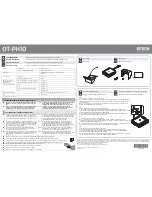
PowerConnect B-Series FCX Configuration Guide
801
53-1002266-01
Configuring IP parameters – Layer 3 Switches
26
NOTE
The ospf-passive option disables adjacency formation but does not disable advertisement of the
interface into OSPF. To disable advertisement in addition to disabling adjacency formation, you must
use the ospf-ignore option.
Use the secondary parameter if you have already configured an IP address within the same subnet
on the interface.
NOTE
When you configure more than one address in the same subnet, all but the first address are
secondary addresses and do not form OSPF adjacencies.
NOTE
All physical IP interfaces on Layer 3 devices share the same MAC address. For this reason, if more
than one connection is made between two devices, one of which is a Layer 3 device, Dell
recommends the use of virtual interfaces. It is not recommended to connect two or more physical
IP interfaces between two routers.
Assigning an IP address to a loopback interface
Loopback interfaces are always up, regardless of the states of physical interfaces. They can add
stability to the network because they are not subject to route flap problems that can occur due to
unstable links between a Layer 3 Switch and other devices. You can configure up to eight loopback
interfaces on a Chassis Layer 3 Switch. You can configure up to four loopback interfaces on a
Compact Layer 3 Switch.
You can add up to 24 IP addresses to each loopback interface.
NOTE
If you configure the Layer 3 Switch to use a loopback interface to communicate with a BGP4
neighbor, you also must configure a loopback interface on the neighbor and configure the neighbor
to use that loopback interface to communicate with the Layer 3 Switch. Refer to
“Adding a loopback
interface”
on page 993.
To add a loopback interface, enter commands such as those shown in the following example.
PowerConnect(config-bgp-router)# exit
PowerConnect(config)# interface loopback 1
PowerConnect(config-lbif-1)# ip address 10.0.0.1/24
Syntax: interface loopback
<num>
The
<num>
parameter specifies the virtual interface number. You can specify from 1 to the
maximum number of virtual interfaces supported on the device. To display the maximum number
of virtual interfaces supported on the device, enter the show default values command. The
maximum is listed in the System Parameters section, in the Current column of the virtual-interface
row.
Refer to the syntax description in
“Assigning an IP address to an Ethernet port”
on page 800.
Summary of Contents for PowerConnect B-FCXs
Page 1: ...53 1002266 01 18 March 2011 PowerConnect B Series FCX Configuration Guide ...
Page 248: ...206 PowerConnect B Series FCX Configuration Guide 53 1002266 01 IPv6 management commands 7 ...
Page 374: ...332 PowerConnect B Series FCX Configuration Guide 53 1002266 01 Jumbo frame support 9 ...
Page 568: ...526 PowerConnect B Series FCX Configuration Guide 53 1002266 01 CLI examples 14 ...
Page 588: ...546 PowerConnect B Series FCX Configuration Guide 53 1002266 01 Sample application 15 ...
Page 684: ...642 PowerConnect B Series FCX Configuration Guide 53 1002266 01 VLAN based mirroring 20 ...
Page 724: ...682 PowerConnect B Series FCX Configuration Guide 53 1002266 01 Reading CDP packets 23 ...
Page 930: ...888 PowerConnect B Series FCX Configuration Guide 53 1002266 01 26 ...
Page 948: ...906 PowerConnect B Series FCX Configuration Guide 53 1002266 01 Configuring MLD snooping 27 ...
Page 1348: ...1306 PowerConnect B Series FCX Configuration Guide 53 1002266 01 Example configurations 36 ...
Page 1406: ...1364 PowerConnect B Series FCX Configuration Guide 53 1002266 01 IP source guard 39 ...
















































